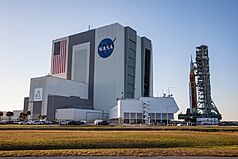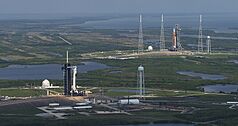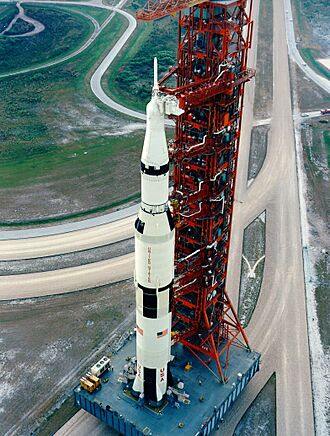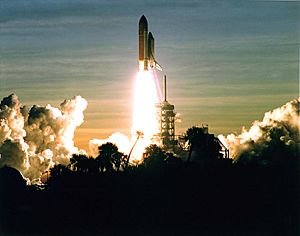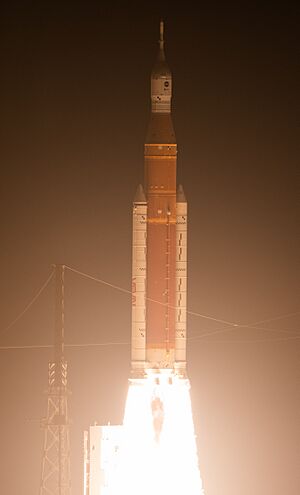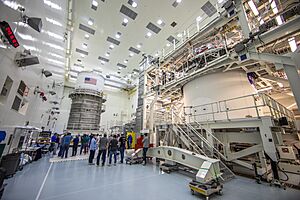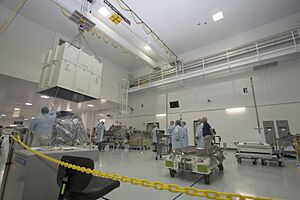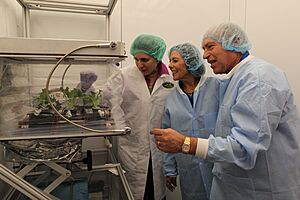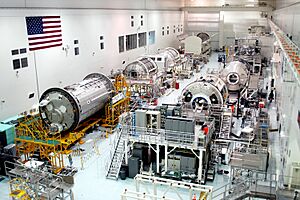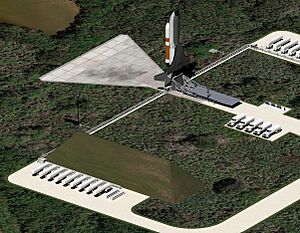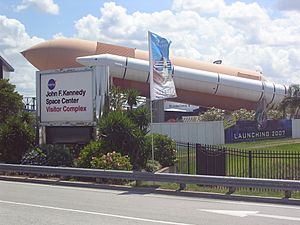Kennedy Space Center facts for kids
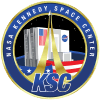 |
|
|
Clockwise from the top: Vehicle Assembly Building, Shuttle Landing Facility, Launch Control Center, Launch Complex 39, KSC Headquarters Building, and the Visitor Complex
|
|
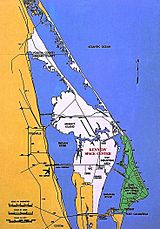
KSC shown in white; CCSFS in green
|
|
| Abbreviation | KSC |
|---|---|
| Named after | John F. Kennedy |
| Formation | July 1, 1962 |
| Type | NASA facility |
| Location | |
| Owner | NASA |
|
Director
|
Janet E. Petro |
|
Budget
|
US$2.074 billion (2023) |
|
Staff
|
13,253 (2023) |
|
Formerly called
|
Launch Operations Center |
The John F. Kennedy Space Center (KSC) is one of NASA's main centers. NASA is America's space agency. KSC is located on Merritt Island, Florida. Since 1968, it has been NASA's main place for launching American spacecraft.
KSC managed launches for the Apollo, Skylab, and Space Shuttle missions. These launches took off from Kennedy Space Center Launch Complex 39. KSC is right next to the Cape Canaveral Space Force Station (CCSFS). Both groups work closely, sharing resources and facilities.
Even though early Apollo, Project Mercury, and Project Gemini flights launched from Cape Canaveral Air Force Station, KSC managed them. After the fourth Gemini mission, NASA's launch control center at KSC started handing over control of the spacecraft to the Mission Control Center in Houston shortly after liftoff.
Today, KSC also manages launches for robotic missions and commercial crew flights. They even research how to grow food and use resources found on other planets for future space travel. Since 2010, KSC has become a spaceport for many users, working with private companies. They even added a new launch pad, LC-39C, in 2015.
KSC has about 700 buildings spread across 144,000 acres (580 km2). Some special buildings include the 525-foot (160 m) tall Vehicle Assembly Building (VAB). This is where NASA's biggest rockets are put together. There's also the Launch Control Center for managing launches. The Operations and Checkout Building has dorms for astronauts and where they get ready. A Space Station factory is also there. Plus, a 3-mile (4.8 km) long Shuttle Landing Facility for spacecraft to land. You can also visit the Kennedy Space Center Visitor Complex to see many of these amazing things.
Contents
How Kennedy Space Center Started
Since 1949, the military had been launching rockets from what is now Cape Canaveral Space Force Station. In 1959, the military gave 5,000 people and a missile lab to NASA. This became the Launch Operations Directorate under NASA's Marshall Space Flight Center.
President John F. Kennedy set a goal in 1961: to land people on the Moon by 1970. This meant NASA needed much bigger launch operations. So, on July 1, 1962, the Launch Operations Directorate became its own center, called the Launch Operations Center (LOC).
Cape Canaveral wasn't big enough for the huge Saturn V rocket. This rocket was 363-foot (111 m) tall and very powerful. It needed to be built upright in a giant hangar and moved to the launch pad. So, NASA decided to build a new launch site next to Cape Canaveral on Merritt Island.
NASA started buying land in 1962. They bought 131 square miles (340 km2) and worked with Florida to get another 87 square miles (230 km2). Much of this land was used for citrus farms. NASA let farmers lease their land back for a while. This helped them manage the change. Everyone entering the area needed special security badges.
The main buildings at KSC were designed by architect Charles Luckman. Construction started in November 1962. President Kennedy visited the site several times before he passed away in November 1963.
On November 29, 1963, President Lyndon B. Johnson named the facility the "John F. Kennedy Space Center." This name included both the civilian LOC and the military Cape Canaveral station. Later, NASA clarified that the Kennedy Space Center name was only for the LOC. The Air Force renamed its launch site Cape Kennedy Air Force Station.
Where KSC is Located
KSC is on Merritt Island, Florida, along the Atlantic Ocean. It's between Miami and Jacksonville, east of Orlando. This area is known as Florida's Space Coast. The center is about 34 miles (55 km) long and six miles (9.7 km) wide, covering 219 square miles (570 km2).
KSC is a popular place for tourists in central Florida. It's about an hour's drive from Orlando. The Kennedy Space Center Visitor Complex offers tours of KSC and the Cape Canaveral Space Force Station.
Before NASA bought the land, it was mostly swamps, citrus groves, and beaches. Some areas had to be dug out to build the facilities. Several small towns, like Shiloh and Allenhurst, were completely taken over by NASA's expansion.
Past Space Programs at KSC
Apollo Program: Going to the Moon
From 1967 to 1973, there were 13 launches of the powerful Saturn V rocket. These included ten Apollo missions after Apollo 7. The first rocket launch from KSC was Apollo 4 on November 9, 1967. This was an uncrewed test flight.
The first crewed Saturn V launch was Apollo 8 on December 21, 1968. This mission orbited the Moon. Apollo 11, launched on July 16, 1969, made the first Moon landing. Astronauts Neil Armstrong, Michael Collins, and Buzz Aldrin were on board. About 650 million people watched the launch on TV. The Apollo program finished at KSC with missions 13 through 17 from 1970 to 1972.
Skylab: America's First Space Station
On May 14, 1973, the last Saturn V rocket launched the Skylab space station into orbit from Pad 39A. Later that year, Pad 39B was used to launch three crewed missions to Skylab. It also launched the final Apollo spacecraft for the Apollo–Soyuz Test Project in 1975.
Space Shuttle: Reusable Spacecraft
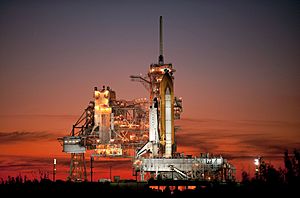
NASA decided to use KSC for the Space Shuttle program. KSC had existing facilities and a good location. Its southern latitude helped rockets get a speed boost when launching into orbit.
The first Space Shuttle, Columbia, launched on April 12, 1981, for its first mission, STS-1. This was NASA's first crewed launch of a vehicle that hadn't been tested with uncrewed flights first.
In 1976, the VAB had a large U.S. flag painted on its side. In the late 1970s, Launch Complex 39 was changed to support the Space Shuttle. Special hangars called Orbiter Processing Facilities were built near the VAB.
KSC's 2.9-mile (4.7 km) Shuttle Landing Facility (SLF) was the main place for the orbiters to land. The first KSC landing happened on February 11, 1984, when Challenger completed STS-41-B. The SLF is one of the longest runways in the world.
Constellation Program
On October 28, 2009, the Ares I-X rocket launched from Pad 39B. This was the first uncrewed launch from KSC since the Skylab workshop in 1973.
Robotic Rocket Launches
Since 1958, NASA and the military worked together on launching robotic missions. In the early 1960s, NASA launched as many as two robotic missions each month. This allowed engineers to quickly improve the rockets.
Most robotic missions launched from the Cape Canaveral Space Force Station (CCSFS). However, KSC oversaw the final assembly and testing of these rockets. From the 1950s to 1978, KSC chose the rockets and prepared them for all robotic missions launched in the U.S. This included missions for other countries and private companies.
Things changed after the Commercial Space Launch Act of 1984. After this, NASA only managed its own and National Oceanic and Atmospheric Administration (NOAA) robotic launches. Private companies could now operate their own rockets and use NASA's launch facilities.
In 1998, the Launch Services Program (LSP) was created at KSC. This program manages the launch of NASA and NOAA robotic missions. LSP payloads, like the Mars Science Laboratory, are prepared at KSC before moving to a launch pad at Cape Canaveral Space Force Station.
Artemis Program: Back to the Moon
On November 16, 2022, the Space Launch System (SLS) rocket launched from Complex 39B. This was part of the Artemis I mission, which is the first step in sending humans back to the Moon.
Preparing Space Station Parts
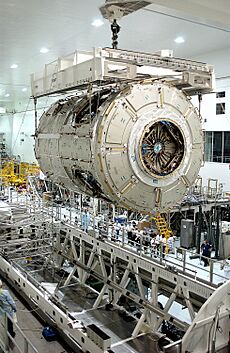
When the International Space Station (ISS) modules were being designed in the early 1990s, KSC helped prepare them for launch. KSC used its experience from preparing 22 Spacelab missions. This knowledge helped design the Space Station Processing Facility (SSPF), which started being built in 1991.
From 1997 to 2007, KSC planned and performed tests of the station modules on the ground. Many problems were found and fixed during these tests. This saved a lot of trouble that would have been very hard to fix in space.
Today, KSC still prepares ISS payloads from all over the world before they launch. They also develop their own experiments for the station. The planned Lunar Gateway space station would also be built and prepared at the Space Station Processing Facility.
What KSC Does Now
Here are some of the main things happening at Kennedy Space Center today:
- Commercial Crew Program: Working with private companies to send astronauts to space.
- Exploration Ground Systems Program: Getting ready for future deep-space missions.
- Launch Services Program: Managing launches for NASA's robotic missions.
- Educational Launch of Nanosatellites (ELaNa): Helping small satellites get into space.
- Research and Technology: Developing new ways to explore space.
- Artemis program: The mission to send humans back to the Moon.
- Lunar Gateway: A planned space station orbiting the Moon.
- International Space Station Payloads: Preparing experiments and supplies for the ISS.
- Camp KSC: Fun educational camps for kids focused on space, aviation, and robotics.
KSC Buildings and Areas
The KSC Industrial Area is where many support buildings are located. It's about 5 miles (8 km) south of LC-39. This area includes the Headquarters Building and the Operations and Checkout Building. Astronauts used to stay in Hangar S at Cape Canaveral before the O&C building was finished.
KSC also had its own 17-mile (27 km) short-line railroad. This railroad was used to move heavy equipment. It stopped operating in 2015.
Preparing Spacecraft and Payloads
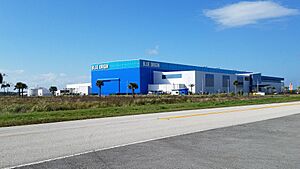
- The Neil Armstrong Operations and Checkout Building (O&C) is a historic building from the 1960s. It was used to prepare parts for the Gemini, Apollo, and Skylab programs. Astronauts would get ready here before heading to the launch pad.
- The Space Station Processing Facility (SSPF) is a huge, three-story building. It has large bays for preparing Space Station and Shuttle payloads in a very clean environment. It opened in 1994 and is the largest factory building in the KSC industrial area.
- The Vertical Processing Facility (VPF) has a large door for bringing in payloads that need to be processed upright. It uses cranes to move heavy items.
- The Payload Hazardous Servicing Facility (PHSF) has a large service bay for handling payloads. It keeps a steady temperature of 70 °F (21 °C).
- The Blue Origin rocket factory is located just south of the KSC visitor complex. It was finished in 2019 and builds New Glenn rockets.
Launch Complex 39: The Moonport
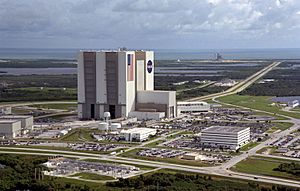
Launch Complex 39 (LC-39) was built for the Saturn V rocket. This was the biggest and most powerful rocket until the Space Launch System. It was used for the Apollo Moon landing program. Since 1968, LC-39 has launched every NASA human spaceflight. This includes Skylab, the Apollo–Soyuz Test Project, and the Space Shuttle program.
All launches have been from launch pads A and B at LC-39. These pads are on the ocean, 3 miles (4.8 km) east of the VAB. From 1969 to 1972, LC-39 was known as the "Moonport" for all six Apollo Moon landing missions. It was also used for all Space Shuttle launches from 1981 to 2011.
The Saturn V rocket was 363 feet (111 meters) tall. Launch Complex 39 was built on Merritt Island to handle this huge rocket. Construction started in November 1962 and cost $800 million. Pads A and B were finished by October 1965. The VAB was completed in June 1965.
The complex includes:
- The Vehicle Assembly Building (VAB), a giant hangar that can hold four Saturn Vs. It was the largest building in the world by volume when it was finished in 1965.
- A transporter that can carry 5,440 tons. It moves rockets along a special road called a crawlerway to the launch pads.
- The Launch Control Center, where all launch operations are managed.
Launch Complex 48
Launch Complex 48 (LC-48) is a new launch site being built for smaller rockets and spacecraft. It will be located between Launch Complex 39A and Space Launch Complex 41. LC-48 is designed to support many different launch systems.
Working with Commercial Companies
KSC leases some of its properties to help grow the commercial space industry. This makes KSC a spaceport for many different users. Here are some examples:
- Exploration Park is leased to many companies.
- The Shuttle Landing Facility is leased to Space Florida, which then lets private companies use it.
- Orbiter Processing Facility (OPF)-3 is leased to Boeing for their CST-100 Starliner spacecraft.
- Launch Complex 39A and parts of the Launch Control Center are leased to SpaceX.
- The O&C High Bay is leased to Lockheed Martin for preparing the Orion spacecraft.
Kennedy Space Center Visitor Complex
The Kennedy Space Center Visitor Complex is a fun place for the public. It has many exhibits, real space artifacts, and attractions about spaceflight. Bus tours of KSC start here. The complex also includes the Apollo/Saturn V Center and the United States Astronaut Hall of Fame. About 1.5 million people visited in 2009.
In 2015, it was announced that the Astronaut Hall of Fame exhibit would move to a new location within the Visitor Complex. A new attraction called "Heroes and Legends" opened in November 2016.
In March 2016, the famous countdown clock was moved to the complex's entrance. This clock was first built in 1969. In 2019, NASA celebrated the 50th anniversary of the Apollo program. A Lunar Module (LM-9) was moved to the Apollo/Saturn V Center as part of these celebrations.
Weather at KSC
Florida often has electrical storms because of its shape and the temperature differences between land and ocean. This area is known as the "lightning capital of the United States." Because of this, KSC needs strong lightning protection systems to keep people, buildings, and spacecraft safe.
On November 14, 1969, Apollo 12 was hit by lightning right after launching from Pad 39A. Luckily, the flight continued safely. The strongest lightning strike at KSC happened on August 25, 2006, at LC-39B. This was when shuttle Atlantis was getting ready for STS-115. No damage was found on Atlantis.
On September 7, 2004, Hurricane Frances hit the area directly. It had strong winds that damaged the Vehicle Assembly Building. About 1,000 outer panels fell off, leaving a large part of the building open. The shuttle's Thermal Protection System Facility also had a lot of damage. Several rockets on display were knocked over. Hurricane Wilma caused more damage in October 2005.
Experts believe that the Space Center will see 5 to 8 inches of sea level rise by the 2050s. Launch Complex 39A, where Apollo 11 launched, is most at risk of flooding.
Leaders of KSC
Since KSC started, eleven NASA officials have been directors. Three of them were former astronauts.
| No. | Image | Director | Start | End | |
|---|---|---|---|---|---|
| 1 |  |
Kurt H. Debus | July 1962 | November 1974 | |
| acting | Miles Ross | November 1974 | January 18, 1975 | ||
| 2 |  |
Lee R. Scherer | January 19, 1975 | September 25, 1979 | |
| 3 |  |
Richard G. Smith | September 26, 1979 | August 2, 1986 | |
| acting | Thomas E. Utsman | August 3, 1986 | September 30, 1986 | ||
| 4 |  |
Forrest S. McCartney | October 1, 1986 | August 31, 1987 | as USAF |
| September 1, 1987 | December 31, 1991 | as civilian | |||
| 5 |  |
Robert L. Crippen | January 1, 1992 | January 21, 1995 | |
| 6 |  |
Jay F. Honeycutt | January 22, 1995 | March 2, 1997 | |
| 7 |  |
Roy D. Bridges, Jr. | March 2, 1997 | June 13, 2003 | |
| acting |  |
James W. Kennedy | June 13, 2003 | August 10, 2003 | |
| 8 | August 10, 2003 | January 4, 2007 | |||
| 9 |  |
William W. Parsons | January 4, 2007 | October 26, 2008 | |
| 10 |  |
Robert D. Cabana | October 26, 2008 | May 17, 2021 | |
| acting |  |
Janet E. Petro | May 17, 2021 | June 29, 2021 | |
| 11 | June 30, 2021 | January 20, 2025 | |||
| acting |  |
Kelvin Manning | January 20, 2025 | Present |
More to Explore
- Air Force Space and Missile Museum
- Astronaut beach house
- NASA Causeway
- Swamp Works
- Crawler-transporter
See also
 In Spanish: Centro espacial John F. Kennedy para niños
In Spanish: Centro espacial John F. Kennedy para niños


